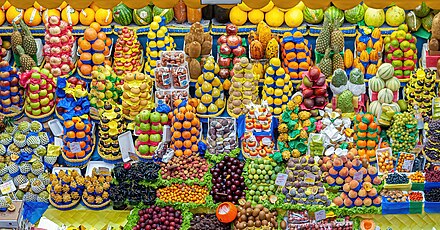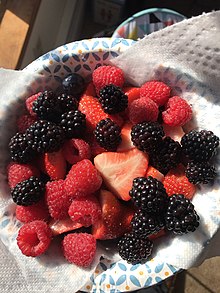
Back Obst ALS Fruita AN فاكهة Arabic فواكه ARZ Fruta AST Obst BAR Садавіна Byelorussian Садавіна BE-X-OLD Voće BS Fruita Catalan


In botany, a fruit is the seed-bearing structure in flowering plants that is formed from the ovary after flowering (see Fruit anatomy).
Fruits are the means by which flowering plants (also known as angiosperms) disseminate their seeds. Edible fruits in particular have long propagated using the movements of humans and other animals in a symbiotic relationship that is the means for seed dispersal for the one group and nutrition for the other; humans and many other animals have become dependent on fruits as a source of food.[1] Consequently, fruits account for a substantial fraction of the world's agricultural output, and some (such as the apple and the pomegranate) have acquired extensive cultural and symbolic meanings.
In common language usage, fruit normally means the seed-associated fleshy structures (or produce) of plants that typically are sweet or sour and edible in the raw state, such as apples, bananas, grapes, lemons, oranges, and strawberries. In botanical usage, the term fruit also includes many structures that are not commonly called 'fruits' in everyday language, such as nuts, bean pods, corn kernels, tomatoes, and wheat grains.[2][3]
- ^ Lewis, Robert A. (2002). CRC Dictionary of Agricultural Sciences. CRC Press. ISBN 978-0-8493-2327-0. Archived from the original on 2024-01-30. Retrieved 2020-10-06.
- ^ Schlegel, Rolf H J (2003). Encyclopedic Dictionary of Plant Breeding and Related Subjects. Haworth Press. p. 177. ISBN 978-1-56022-950-6. Archived from the original on 2024-01-30. Retrieved 2020-10-06.
- ^ Mauseth, James D. (2003). Botany: An Introduction to Plant Biology. Jones and Bartlett. pp. 271–72. ISBN 978-0-7637-2134-3. Archived from the original on 2024-01-30. Retrieved 2020-05-09.